对JAVA集合进行遍历删除时务必要用迭代器
今天同事写了几行类似这样的代码:
package cn.iigrowing.threads.study.CollectionModify;
import java.util.ArrayList;
import java.util.List;
public class ConcurrentModificationExceptionDemo {
public static void main(String args[]) {
List<String> famous = new ArrayList<String>();
famous.add(“liudehua”);
famous.add(“madehua”);
famous.add(“liushishi”);
famous.add(“tangwei”);
for (String s : famous) {
if (s.equals(“madehua”)) {
famous.remove(s);
}
}
}
}
运行出异常:
Exception in thread “main” java.util.ConcurrentModificationException
at java.util.AbstractList$Itr.checkForComodification(AbstractList.java:372)
at java.util.AbstractList$Itr.next(AbstractList.java:343)
at com.bes.Test.main(Test.java:15)
Java新手最容易犯的错误,对JAVA集合进行遍历删除时务必要用迭代器。切记。
其实对于如上for循环,运行过程中还是转换成了如下代码:
package cn.iigrowing.threads.study.CollectionModify;
import java.util.ArrayList;
import java.util.Iterator;
import java.util.List;
public class ConcurrentModificationExceptionDemoErr2 {
public static void main(String args[]) {
List<String> famous = new ArrayList<String>();
famous.add(“liudehua”);
famous.add(“madehua”);
famous.add(“liushishi”);
famous.add(“tangwei”);
for (Iterator<String> it = famous.iterator(); it.hasNext();) {
String s = it.next();
if (s.equals(“madehua”)) {
famous.remove(s);
}
System.out.println(s);
}
}
}
仍然采用的是迭代器,但删除操作却用了错误的方法。如将famous.remove(s)改成it.remove()
则运行正常,结果也无误。
—
package cn.iigrowing.threads.study.CollectionModify;
import java.util.ArrayList;
import java.util.Iterator;
import java.util.List;
public class ConcurrentModificationExceptionDemoOk {
public static void main(String args[]) {
List<String> famous = new ArrayList<String>();
famous.add(“liudehua”);
famous.add(“madehua”);
famous.add(“liushishi”);
famous.add(“tangwei”);
// 打印全部集合
for (Iterator<String> it = famous.iterator(); it.hasNext();) {
if (it.hasNext()) {
System.out.println(it.next());
}
}
System.out.println(“—————“);
for (Iterator<String> it = famous.iterator(); it.hasNext();) {
String s = it.next();
if (s.equals(“madehua”)) {
it.remove();
}
}
// 打印处理完成的 情况
for (Iterator<String> it = famous.iterator(); it.hasNext();) {
if (it.hasNext()) {
System.out.println(it.next());
}
}
}
}
—
当然如果改成:
——-
package cn.iigrowing.threads.study.CollectionModify;
import java.util.ArrayList;
import java.util.Iterator;
import java.util.List;
public class ConcurrentModificationExceptionDemoOk2 {
public static void main(String args[]) {
List<String> famous = new ArrayList<String>();
famous.add(“liudehua”);
famous.add(“madehua”);
famous.add(“liushishi”);
famous.add(“tangwei”);
// 打印全部集合
for (Iterator<String> it = famous.iterator(); it.hasNext();) {
if (it.hasNext()) {
System.out.println(it.next());
}
}
System.out.println(“—————“);
for (int i = 0; i < famous.size(); i++) {
String s = famous.get(i);
if (s.equals(“madehua”)) {
famous.remove(s);
}
}
// 打印处理完成的 情况
for (Iterator<String> it = famous.iterator(); it.hasNext();) {
if (it.hasNext()) {
System.out.println(it.next());
}
}
}
}
——-
这种方法,也是可以完成功能,但一般也不这么写。
为什么用了迭代码器就不能采用famous.remove(s)操作? 这种因为ArrayList与Iterator混合使用时会导致各自的状态出现不一样,最终出现异常。
我们看一下ArrayList中的Iterator实现:
private class Itr implements Iterator<E> {
/**
* Index of element to be returned by subsequent call to next.
*/
int cursor = 0;
/**
* Index of element returned by most recent call to next or
* previous. Reset to -1 if this element is deleted by a call
* to remove.
*/
int lastRet = -1;
/**
* The modCount value that the iterator believes that the backing
* List should have. If this expectation is violated, the iterator
* has detected concurrent modification.
*/
int expectedModCount = modCount;
public boolean hasNext() {
return cursor != size();
}
public E next() {
checkForComodification();
try {
E next = get(cursor);
lastRet = cursor++;
return next;
} catch (IndexOutOfBoundsException e) {
checkForComodification();
throw new NoSuchElementException();
}
}
public void remove() {
if (lastRet == -1)
throw new IllegalStateException();
checkForComodification();
try {
AbstractList.this.remove(lastRet);
if (lastRet < cursor)
cursor–;
lastRet = -1;
expectedModCount = modCount;
} catch (IndexOutOfBoundsException e) {
throw new ConcurrentModificationException();
}
}
final void checkForComodification() {
if (modCount != expectedModCount)
throw new ConcurrentModificationException();
}
}
基本上ArrayList采用size属性来维护自已的状态,而Iterator采用cursor来来维护自已的状态。
当size出现变化时,cursor并不一定能够得到同步,除非这种变化是Iterator主动导致的。
从上面的代码可以看到当Iterator.remove方法导致ArrayList列表发生变化时,他会更新cursor来同步这一变化。但其他方式导致的ArrayList变化,Iterator是无法感知的。ArrayList自然也不会主动通知Iterator们,那将是一个繁重的工作。Iterator到底还是做了努力:为了防止状态不一致可能引发的无法设想的后果,Iterator会经常做checkForComodification检查,以防有变。如果有变,则以异常抛出,所以就出现了上面的异常。
如果对正在被迭代的集合进行结构上的改变(即对该集合使用add、remove或clear方法),那么迭代器就不再合法(并且在其后使用该迭代器将会有ConcurrentModificationException异常被抛出).
如果使用迭代器自己的remove方法,那么这个迭代器就仍然是合法的。
package chapter1;
import java.util.HashMap;
import java.util.Iterator;
import java.util.Map;
/**
* Created by MyWorld on 2016/3/3.
*/
public class FastFailResolver {
public static void main(String[] args) {
Map<String, String> source = new HashMap<String, String>();
for (int i = 0; i < 10; i++) {
source.put(“key” + i, “value” + i);
}
System.out.println(“Source:” + source);
// fastFailSceneWhenRemove(source);
commonSceneWhenRemove(source);
}
private static void commonSceneWhenRemove(Map<String, String> source) {
Iterator<Map.Entry<String, String>> iterator = source.entrySet().iterator();
while (iterator.hasNext()) {
Map.Entry<String, String> entry = iterator.next();
if (entry.getKey().contains(“1″)) {
iterator.remove();
}
}
System.out.println(source);
}
private static void fastFailSceneWhenRemove(Map<String, String> source) {
for (Map.Entry<String, String> entry : source.entrySet()) {
if (entry.getKey().contains(“1″)) {
source.remove(entry.getKey());
}
}
System.out.println(source);
}
}
3.在一个循环中删除一个列表中的元素
思考下面这一段在循环中删除多个元素的的代码
ArrayList<String> list = new ArrayList<String>(Arrays.asList(“a”,”b”,”c”,”d”));
for(int i=0;i<list.size();i++){
list.remove(i);
}
System.out.println(list);
输出结果是:
1
[b,d]
在这个方法中有一个严重的错误。当一个元素被删除时,列表的大小缩小并且下标变化,所以当你想要在一个循环中用下标删除多个元素的时候,它并不会正常的生效。
与下面结合的一个示例:
public static void main(String[] args) {
ArrayList<String> list = new ArrayList<String>(Arrays.asList(“a”,”a”, “b”,
“c”, “d”));
for (int i = 0; i < list.size(); i++) {
if (list.get(i).equals(“a”)) {
list.remove(i);
}
}
System.out.println(list);
}
输出:
[a, b, c, d]
即输出与预期不一致
你也许知道在循环中正确的删除多个元素的方法是使用迭代,并且你知道java中的foreach循环看起来像一个迭代器,但实际上并不是。考虑一下下面的代码:
ArrayList<String> list = new ArrayList<String>(Arrays.asList(“a”,”b”,”c”,”d”));
for(String s:list){
if(s.equals(“a”)){
list.remove(s);
}
}
它会抛出一个ConcurrentModificationException异常。 相反下面的显示正常:
ArrayList<String> list = new ArrayList<String>(Arrays.asList(“a”,”b”,”c”,”d”));
Iterator<String> iter = list.iterator();
while(iter.hasNext()){
String s = iter.next();
if(s.equals(“a”)){
iter.remove();
}
}
.next()必须在.remove()之前调用。在一个foreach循环中,编译器会使.next()在删除元素之后被调用,因此就会抛出ConcurrentModificationException异常,你也许希望看一下ArrayList.iterator()的源代码。
http://www.cnblogs.com/softidea/p/4279574.html
import java.util.ArrayList;
import java.util.Iterator;
import java.util.List;
public class IteratorTest{
public static void main(String[] args) {
List<String> list = new ArrayList<String>();
list.add(“Test1″);
list.add(“Test2″);
list.add(“Test3″);
list.add(“Test4″);
list.add(“Test5″);
for(Iterator<String> it = list.iterator();it.hasNext();){
if(it.next().equals(“Test3″)){
it.remove();
}
}
for(String s : list){
System.out.println(s);
}
}
}
Iterator 支持从源集合中安全地删除对象,只需在 Iterator 上调用 remove() 即可。这样做的好处是可以避免 ConcurrentModifiedException ,这个异常顾名思意:当打开 Iterator 迭代集合时,同时又在对集合进行修改。
有些集合不允许在迭代时删除或添加元素,但是调用 Iterator 的remove() 方法是个安全的做法。
java.util.ConcurrentModificationException详解
http://blog.csdn.net/smcwwh/article/details/7036663
【引言】
经常在迭代集合元素时,会想对集合做修改(add/remove)操作,类似下面这段代码:
for (Iterator<Integer> it = list.iterator(); it.hasNext(); ) {
Integer val = it.next();
if (val == 5) {
list.remove(val);
}
}
运行这段代码,会抛出异常java.util.ConcurrentModificationException。
【解惑】
(以ArrayList来讲解)在ArrayList中,它的修改操作(add/remove)都会对modCount这个字段+1,modCount可以看作一个版本号,每次集合中的元素被修改后,都会+1(即使溢出)。接下来再看看AbsrtactList中iteraor方法
public Iterator<E> iterator() {
return new Itr();
}
它返回一个内部类,这个类实现了iterator接口,代码如下:
private class Itr implements Iterator<E> {
int cursor = 0;
int lastRet = -1;
int expectedModCount = modCount;
public boolean hasNext() {
return cursor != size();
}
public E next() {
checkForComodification();
try {
E next = get(cursor);
lastRet = cursor++;
return next;
} catch (IndexOutOfBoundsException e) {
checkForComodification();
throw new NoSuchElementException();
}
}
public void remove() {
if (lastRet == -1)
throw new IllegalStateException();
checkForComodification();
try {
AbstractList.this.remove(lastRet);
if (lastRet < cursor)
cursor–;
lastRet = -1;
// 修改expectedModCount 的值
expectedModCount = modCount;
} catch (IndexOutOfBoundsException e) {
throw new ConcurrentModificationException();
}
}
final void checkForComodification() {
if (modCount != expectedModCount)
throw new ConcurrentModificationException();
}
}
在内部类Itr中,有一个字段expectedModCount ,初始化时等于modCount,即当我们调用list.iterator()返回迭代器时,该字段被初始化为等于modCount。在类Itr中next/remove方法都有调用checkForComodification()方法,在该方法中检测modCount == expectedModCount,如果不相当则抛出异常ConcurrentModificationException。
前面说过,在集合的修改操作(add/remove)中,都对modCount进行了+1。
在看看刚开始提出的那段代码,在迭代过程中,执行list.remove(val),使得modCount+1,当下一次循环时,执行 it.next(),checkForComodification方法发现modCount != expectedModCount,则抛出异常。
【解决办法】
如果想要在迭代的过程中,执行删除元素操作怎么办?
再来看看内部类Itr的remove()方法,在删除元素后,有这么一句expectedModCount = modCount,同步修改expectedModCount 的值。所以,如果需要在使用迭代器迭代时,删除元素,可以使用迭代器提供的remove方法。对于add操作,则在整个迭代器迭代过程中是不允许的。 其他集合(Map/Set)使用迭代器迭代也是一样。
当使用 fail-fast iterator 对 Collection 或 Map 进行迭代操作过程中尝试直接修改 Collection / Map 的内容时,即使是在单线程下运行, java.util.ConcurrentModificationException 异常也将被抛出。
Iterator 是工作在一个独立的线程中,并且拥有一个 mutex 锁。
Iterator 被创建之后会建立一个指向原来对象的单链索引表,当原来的对象数量发生变化时,这个索引表的内容不会同步改变,所以当索引指针往后移动的时候就找不到要迭代的对象,所以按照 fail-fast 原则 Iterator 会马上抛出 java.util.ConcurrentModificationException 异常。
所以 Iterator 在工作的时候是不允许被迭代的对象被改变的。
但你可以使用 Iterator 本身的方法 remove() 来删除对象, Iterator.remove() 方法会在删除当前迭代对象的同时维护索引的一致性。
有意思的是如果你的 Collection / Map 对象实际只有一个元素的时候, ConcurrentModificationException 异常并不会被抛出。这也就是为什么在 javadoc 里面指出: it would be wrong to write a program that depended on this exception for its correctness: ConcurrentModificationException should be used only to detect bugs.
来源: https://www.cnblogs.com/goody9807/p/6432904.html
————-
Java集合迭代时修改
本文主要分如下几个要点:
0)Java集合分类 1)对于熟悉JDK集合源码的帮你加深对ConcurrentModificationException的下印象 2)对于迭代时修改提供一个正确的姿势。 3)单线程和多线程环境下迭代时修改的方案
PS:本文不会详细讲解每个集合的源码,也不会画出集合的继承关系(网上有太多详细的讲解和关系图)我们从另一个角度来看下集合,看你是否真正理解集合(容器)。
集合(也叫容器)归类
- 普通容器: List/Set/Map
- 同步容器:Vector/HashTable
- 并发容器:CopyOnWriteArrayList、ConcurrentHashMap、ArrayBlockQueue
java多线程与集合以及与你的应用程序的性能有着千丝万缕的关系。
什么是集合?
对java而言就是对一些数据结构如:数组、链表、队列、栈、以及KV对, 进行增、删、改、查、统计的内存操作,
我们都知道在内存中操作要比查询数据库写文件性能高得多,集合就是装你要做操数据的内存容器。
集合在框架中使用一定要谨慎,我们的应用大部分都是基于Spring的,那么你的Controller也基本都是单例的,如果你在Controller中有个成员是集合,你的浏览器(本质是SocketClient)每次请求到你Contorller(web容器如tomtcat接收到请求后分配一个线程来调用你的Servlet,你的应用如果是SpringMvc的话DispatchServert会将请求Mapping到你的Contorller上),这样就成了多个线程操作同一个集合了。
我们以List来举例说明下这几类结合的差别:
数组:有序可放入重复元素的同类型连续的内存区域。
几乎没什么方法,只有几个属性,你可以想象下如果在特定位置删除或者添加一个元素?
以添加的为例:
检查数组是否是满了
1)满了:换个大点的,特定位置的元素和原先老数组的全都放入到这个大的数组,
2)未满:这个位置的元素之后的每个都往后移动一下,将新的元素插入进来。
总之写代码的话就是一大坨,重复性的
List就是就是为了解决这个数组没有方法的问题的,提供add、remove、迭代、统计
我们以迭代时修改为例对比下这几类集合。
单线程环境迭代修改
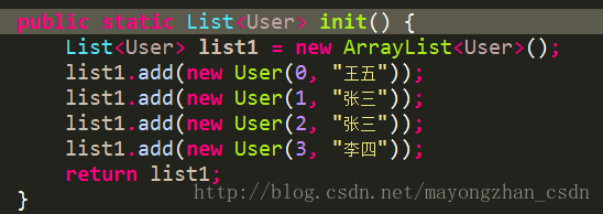
最原始的迭代删除方式:
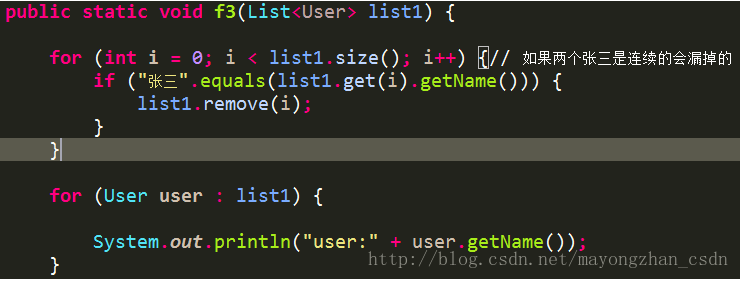
单线程环境下都不能完美正常运行,最明显的问题就是连续的集合值是符合条件的就少删除,原因就是List中的数组的下标变化了【我用的是list1.size()方法】。解决方法也就显而易见了:
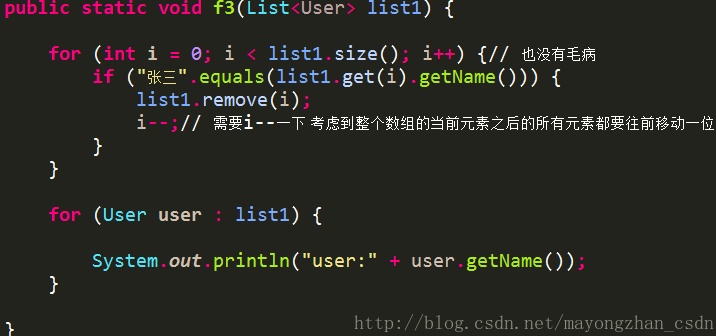
删除的时候将下标减去1,保持下标是下一个真正要迭代的元素。
正确的姿势:
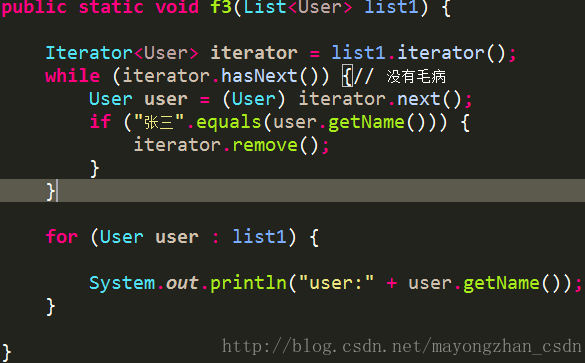
ps增强的for底层是Iterator,把for循环迭代看做是迭代iterator就行
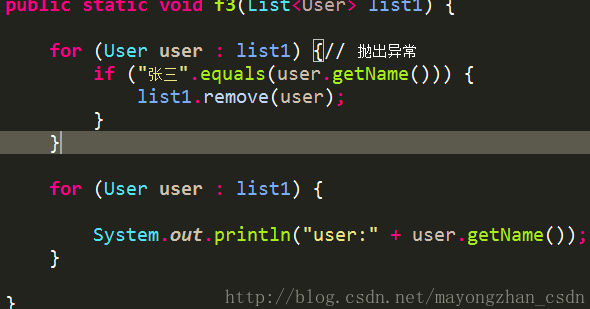
前面说过for和iterator迭代的方式是一样的。可以看出我们这里只是用iterator.remove和list.remove不同而已。
抛出的异常就是ConcurrentModificationException,看下它是怎么出来的这个异常。
 只要expectedModeCount!=modCount就会抛出异常
只要expectedModeCount!=modCount就会抛出异常


每次迭代 即便是增强的for都会new Itr 所以这个expectedModeCount=modCount
在看下这个modCount是怎么回事

就是一个ArrayList的成员,什么时候modCount的值会变化,add和remove方法都modCount++ 也就是容器被修改的时候会调用导致这个值发生变化,也就是说在迭代的过程中如果有容器被修改就会抛出这个异常。
用增强的for或者迭代器本身迭代的时候如果不是调用迭代器自身的remove方法,而是调用了list自身的方法的时候就会抛出ConcurrentModificationException异常。说到这这里单线程环境下调用使用迭代就完了。
多线程环境迭代修改
3个方法
updateRef在修改集合中的应用,并没有调用list的能使得mountCount值发生变化的
public class ListModifyGo {
static List<User> list1 = null;
static {
list1 = new ArrayList<User>();
list1.add(new User(0, "王五"));
list1.add(new User(1, "张三"));
list1.add(new User(2, "张三"));
list1.add(new User(3, "李四"));
}
//迭代结合
void list() {
for (User user : list1) {
try {
Thread.sleep(1);
} catch (InterruptedException e) {
e.printStackTrace();
}
System.out.println(user.getName());
}
}
//使用集合方法删除某个元素,目的是引起mountCount++
void update() {
list1.remove(2);
}
//不用引起mountCount++
void updateRef() {
User user = list1.get(3);
user.setName(user.getName() + " update");
}
public static void main(String[] args) throws Exception {
ListModifyGo listModifyGo = new ListModifyGo();
new Thread(new Runnable() {
@Override
public void run() {
System.out.println(Thread.currentThread().getName() + ",listModifyGo.list();");
listModifyGo.list();
}
}, "t1").start();
new Thread(new Runnable() {
@Override
public void run() {
System.out.println(Thread.currentThread().getName() + ",listModifyGo.update();");
listModifyGo.update();
}
}, "t2").start();
}
}
这个类很简单就是模拟两个线程一个操作同一个对象static List< User > list1
一个线程在调用list一个在调用update 本来两个方法互不干扰,但是在多线程环境下还是出现了我们不希望看到的ConcurrentModificationException异常,当然你可以在每个方法上加上synchronize,但这是你用容器的本质(提升访问速度),这样一来成了排队了违反了你使用容器的本质(性能降低了)。
有人就可能说把List换成线程安全的Vector。答案其实是否定的
public class VectorModifyGo {
static Vector<User> vector = null;
static {
vector = new Vector<User>();
vector.add(new User(0, "王五"));
vector.add(new User(1, "张三"));
vector.add(new User(2, "张三"));
vector.add(new User(3, "李四"));
}
// synchronized 将list()变成是原子操作
void list() {
for (User user : vector) {// next方法被多次调用,list()是复合操作
try {
Thread.sleep(1);
} catch (InterruptedException e) {
e.printStackTrace();
}
System.out.println(user.getName());
}
}
void update() {
vector.remove(2);
}
void updateRef() {
User user = vector.get(3);
user.setName(user.getName() + " update");
}
public static void main(String[] args) throws Exception {
VectorModifyGo vectorModifyGo = new VectorModifyGo();
new Thread(new Runnable() {
@Override
public void run() {
System.out.println(Thread.currentThread().getName() + ",vectorModifyGo.list();");
vectorModifyGo.list();
}
}, "t1").start();
new Thread(new Runnable() {
@Override
public void run() {
System.out.println(Thread.currentThread().getName() + ",vectorModifyGo.update();");
vectorModifyGo.update();
}
}, "t2").start();
}
}
我自己试过,也会看了下Vector源码,只是在Vector相应的 读写方法上加上了synchronized关键字,所有的线程走在抢占Vectory对象的锁this 但是他不能坚决此类问题,它可以解决诸如线程1在统计时候线程2不能修改(add、remove、某个下标的对象里的值都不能修改)能做到互斥。
我说下这里为什么不能,并且这个异常是随机出现的


for迭代的时候也就是new Itr()这个步骤是互斥了将modeCount赋值成了初始值,但是new完之后退出了方法体没有synchronized保护了,这个时候有可能线程2获取锁执行了remove方法modeCount++了,再迭代next方法此时就有问题。
如果线程2在remove抢占锁失败即被迭代时每次next都能成功获取锁,这个时候就不会出现异常,这要是这个异常出现的偶然性。
这种场景是典型的复合操作,多个加锁的方法被同一个方法,方法体内还是暴露了共享对象,这样在多线程环境下还是有问题的。
解决方案1:
在类的list方法上在加上synchronized让所有的next方法都在外层的然而这样锁上锁会损失性能。
解决方案2:
使用java.util.concurrent并发包下的并发容器 注入CopyOnWriteArrayList
原理就是当线程1在迭代的时候迭代的当前数组
线程2修改的时候将当前数组拷贝一份进行迭代,然后将拷贝和修改之后的数组赋值给当前数组
所以线程1迭代的时候老的数据,有些人可能不明白为什么线程1迭代的时老的数据一张图解析下:
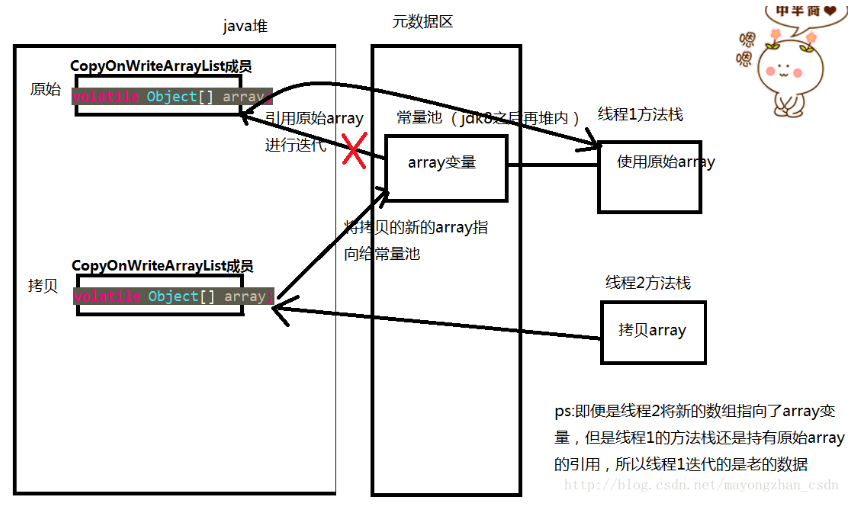
再多说一嘴,CopyOnWriteArrayList的成员array是被volatile修饰的线程2将引用赋值之后其他线程拷贝了应用之后都能感知到array的变化。但是由于线程1执行的list已经在使用原始array了,能感知到也没有用了,而其他线程3如果刚进入方法执行list此时在如果还没有使用这块原始区域则还会重新从主存load即拷贝过后的array,这块其实是java内存模型的之后可以关注下volatile的内存原语。
这种并发容器虽然能解决多线程环境操作同一个集合的情况,但是拷贝一份的代价其实也是很大的,所以更加适用于读多写少的场景。
顺便贴一下代码修改的时候能够看到是赋值了一份:
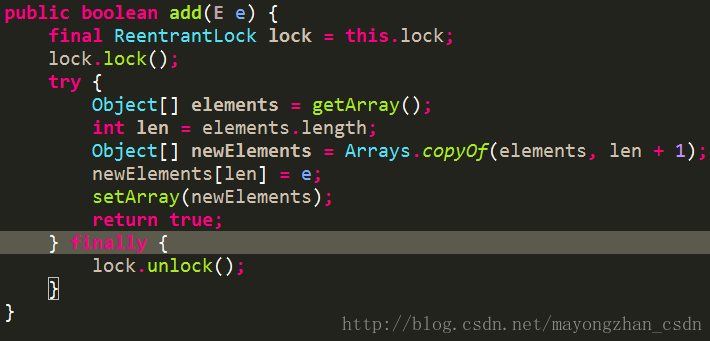
可以看到CopyOnWriteArrayList在执行修改数组的时候拷贝了一份并且加锁了,我上图中没有表示出线程2
在修改时候是独占的,这里补充下。
来源:https://blog.csdn.net/mayongzhan_csdn/article/details/79309722
- 本文标签: App 本质 缩小 update tar http 多线程 希望 key 索引 tab final 安全 ORM CTO bug 解决方法 并发 java 统计 IDE Java集合 遍历 ConcurrentHashMap 源码 锁 cat queue 代码 一致性 SpringMVC synchronized spring js src 数据 MQ 解析 HashTable volatile 编译 线程 ACE SDN 模型 list equals https client UI Collection HTML HashMap Java内存模型 web 数据库 删除 内存模型 id value ArrayList servlet 同步 map IO
- 版权声明: 本文为互联网转载文章,出处已在文章中说明(部分除外)。如果侵权,请联系本站长删除,谢谢。
- 本文海报: 生成海报一 生成海报二











![[HBLOG]公众号](https://www.liuhaihua.cn/img/qrcode_gzh.jpg)

